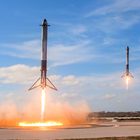
Falcon Heavy Launch on 12.April 主播-胡玉成
介绍: The Falcon Heavy roared into space 3 days ago on 12 April ,Beijing Time 6:35 in the morning,, arcing atop three columns of flame toward orbit with a large satellite on board.
It was the second launch for what is the most powerful rocket in operation today, a reminder of its majestic test launch fourteen mont...
介绍: The Falcon Heavy roared into space 3 days ago on 12 April ,Beijing Time 6:35 in the morning,, arcing atop three columns of flame toward orbit with a large satellite on board.
It was the second launch for what is the most powerful rocket in operation today, a reminder of its majestic test launch fourteen months ago from the same launchpad, 39A, at NASA’s Kennedy Space Center in Florida.
At moments, the 2018 launch seemed like a lengthy advertisement for the ambitions of Elon Musk, SpaceX’s founder and chief executive. It carried a spacesuit-wearing mannequin, nicknamed Starman, seated in the driver’s seat of a red Roadster built by Mr. Musk’s other company, Tesla. The sports car and its driver streamed video back to Earth of their journey out into the solar system.
This time, the Falcon Heavy’s cargo was more mundane, but also more useful: Arabsat-6A, a Saudi Arabian communications satellite which will relay television, internet and mobile phone signals to the Middle East, Africa and Europe.
Shortly after the launch, the rocket’s three boosters returned to Earth. Two touched down seconds apart at landing pads at Cape Canaveral, not far from the launchpad. The center booster, which went higher and farther, set down on a floating platform in the Atlantic Ocean.
Sticking that third landing was an advancement for SpaceX, after a similar maneuver failed in 2018 on the first try. The booster then missed the platform, hitting the water at more than 300 miles per hour.
Now,14 months has gone past.Even though the first Falcon Heavy flight appeared to be nearly flawless, SpaceX probably made adjustments. That, after all, is the reason a rocket company performs a test flight for a new rocket design.
SpaceX also has had a backlog of Falcon 9 missions to fly. It launched 20 Falcon 9 missions in 2018, more than in any previous year, in addition to the one Falcon Heavy launch. The company was also busy at work developing its Crew Dragon capsule for taking NASA astronauts to and from the International Space Station.
The market for the Falcon Heavy is also much smaller than once envisioned. When Mr. Musk first announced the rocket in 2011, he said he expected that there would be a 50/50 mix between the Falcon 9 and the Falcon Heavy. In the years since, improvements have made the Falcon 9 more powerful, and miniaturization of electronics has shrunk the size of many satellites.
The Falcon Heavy is now needed for only the largest satellites like the 13,000-pound Arabsat-6A satellite, which is headed to geosynchronous orbit more than 22,000 miles above Earth. The satellite could have been launched on a Falcon 9, but with the added thrust of a Heavy, the satellite could use less of its own fuel to reach its final orbit, extending its lifetime.Which is valuable for a 5 billion dollars satellite.




